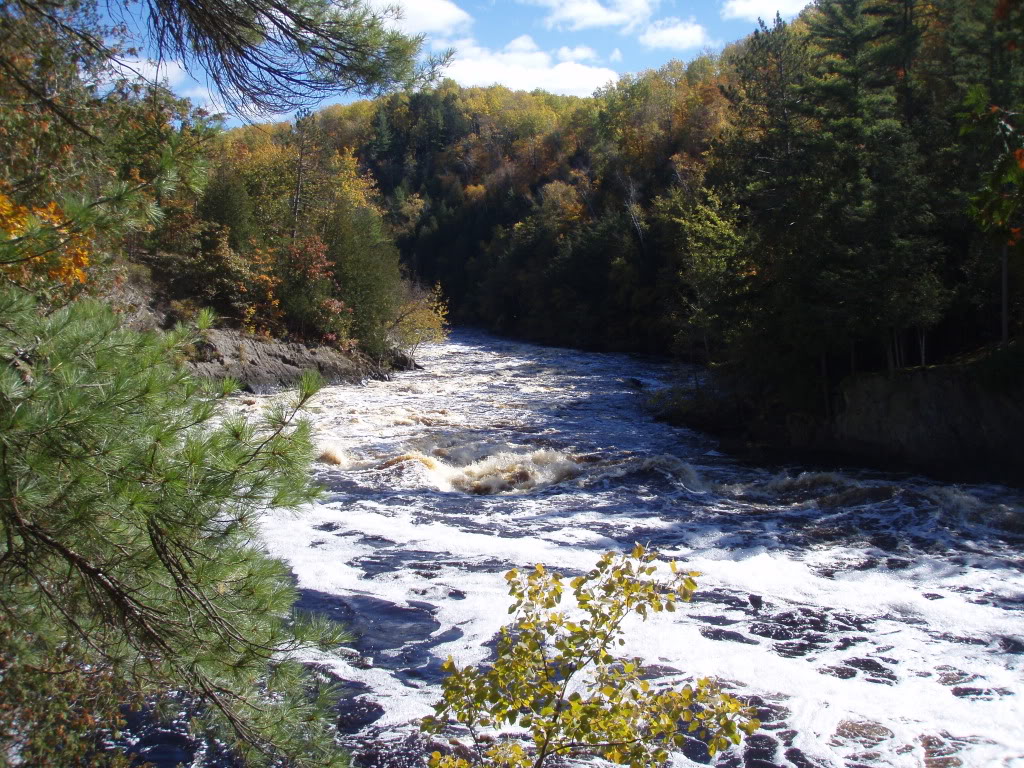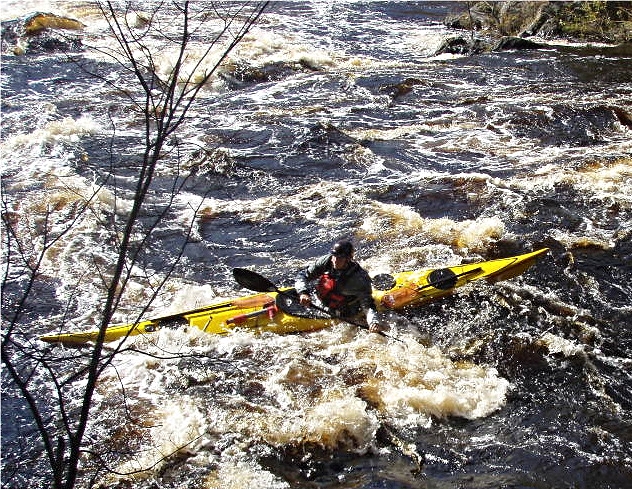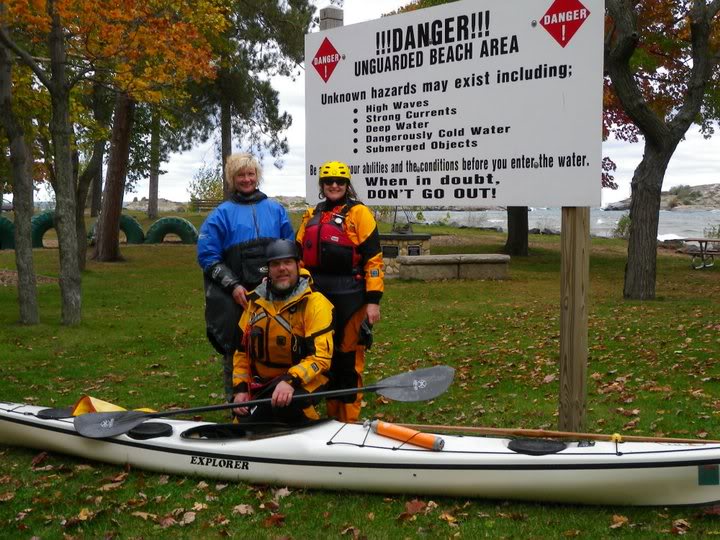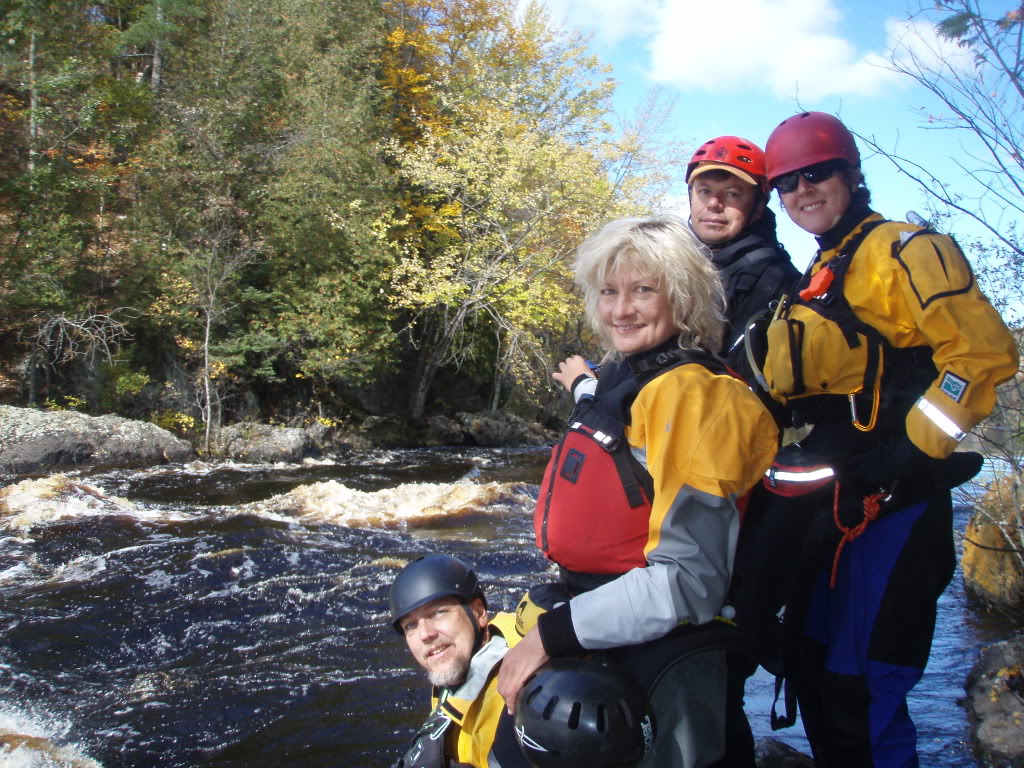By Mary Fairchild
 Menominee River, Piers Gorge, Spring of 2010; CFS 3000.
Menominee River, Piers Gorge, Spring of 2010; CFS 3000.
The Fox River Valley in Yorkville, Illinois, is expected to attract paddlers from throughout the Midwest as well as become an area for paddling instructors as a year-round teaching environment at the first whitewater park in the area.
 Ryan Rushton, L4 longboat training on the Menominee River, Oct. 2010. *2013: Surfing My First Hole at Piers Gorge
Ryan Rushton, L4 longboat training on the Menominee River, Oct. 2010. *2013: Surfing My First Hole at Piers Gorge
Ryan Rushton, pictured above during his L4 Open Water training last October, is the owner of the Geneva Kayak Center in Yorkville, Illinois, and he writes on his website:
“Our tidal current training utilizes select features on the Menominee River, a high volume class II-III whitewater river that is well suited to long sea kayaks. On the river we’ll work on long boat rough water handling skills including eddy turns, peel outs, ferry glides and attainments as well as improving overall stability in the boat. The Menominee River consistently offers conditions with sufficient current that could only be found in areas on the sea with large tidal variances during spring tides…”
 Mary Fairchild, Sarah Hartman, and Jeff Forseth; L4 Open Water Training, 8/10/10, Marquette, MI.
Mary Fairchild, Sarah Hartman, and Jeff Forseth; L4 Open Water Training, 8/10/10, Marquette, MI.
During our Level 4 Open Water Training in Marquette on Lake Superior, while having lunch on a small island about 300 yards from shore, we suddenly heard firetrucks. Soon, we saw them and two more emergency vehicles along with a TV truck onshore. Just as we noticed they were pointing at us the coastguard made its way over only to find that we were just training and having some fun. This course is designed for a coastal/sea environment with winds up to Force 5 (16-20 knots)/Sea State 5. (Sea State Chart.)
Peggy Oneal of Inland Sea Kayakers of Minnesota records the events on her blog, Along the Way, “The forecast for Saturday was ‘North winds to 25 knots, waves 7-11 feet.’ That would exceed level 4 conditions which are 3-5 foot seas, 15-20 knots of wind. Clearly we had no worries about lack of conditions.”
 Jeff Forseth, Mary Fairchild, Paul Redzimski, and Peggy Oneal.
Jeff Forseth, Mary Fairchild, Paul Redzimski, and Peggy Oneal.
“We feel like we’ve built a top sea kayak school between the coasts. In regards to our sea kayak training programs, we’ll continue to build upon last year’s successful new programs, the 2-day Coastal Kayak Weekend and 3-day Open Water Training Weekend. We’ve done some tinkering with our training programs and are adding a new class that is a ‘next step’ beginner class. We are also very excited about the new Yorkville whitewater park where we are expanding our excellent programming into the whitewater and open canoe disciplines. Expect to see similar ‘leveled’ courses and some exciting workshops for whitewater paddlers and canoeists.” Ryan Rushton
Peggy Oneal continues on her blog:
“The water had been around 1000 CFS when I’d been there in early June; now it was around 3000 CFS. As Ryan said, it was ‘kind of pushy.’ According to the Wisconsin Paddle Guide, ‘Piers Gorge is a high adrenaline action run that features Missicot Falls in Piers Gorge, a class 4+ drop that should only be attempted by advanced and expert kayakers, or on a guided rafting trip. The run through Piers Gorge is comparable to many of the big action rivers out west, though it may not have the huge drops, the sheer volume and velocity of the water flow raises the hazard level considerably.’ It goes on to say, ‘Kayakers should not attempt at high water levels. When river levels rise above 3000 CFS, some of the holes below Missicot Falls become quite powerful and have been known to de-boat paddlers into an unpleasant half mile swim.’ On Friday, we spent the day at ‘Terminal Surfer.’ We were at the bottom end of the rapids and worked on the eddy lines. In June we had few or no capsizes; this time they were pretty regular…”
Aspen Kayak Academy’s Charlie MacArthur is called “the king of kayaking” in Aspen, Colorado. The Aspen Times writes, “MacArthur grew up as a surfer in Los Angeles, but when he found the ‘perfect wave’ on the rivers around Aspen, his life changed.”
“I started to go on the rivers to get “the fix” when I couldn’t get to the ocean or wait for gales.” Charlie MacArthur (Youtube)
MacArthur shares on YouTube:
“For a lot of us, we just don’t do one thing. We paddle canoes, longboard, snowboard, … snowshoe, XC ski… I started to go to the rivers to get ‘the fix’ when I couldn’t get to the ocean or wait for gales. Once you understand the standing waves in the river you can actually spend some time and get knocked around by the whitewater and the current.”
“You really don’t have much hull speed unless you are surfing a standing wave. Most of the time you’re not going the same speed as the current or maybe a knot or two faster so its quite a bit less stable than it is in the ocean where you’re either paddling in flatwater or you’re gliding on a wave and you have hull speed.”
“One of the more challenging things of sea kayaking in the river is going through a wave-train. You have sets of waves in the ocean and in the river you call it the same sort of phenomenon, wave-train. The waves in the river are much smaller than in the ocean on average but the wave period is much smaller. It’s like going through a mogul field on your skis. Then you are also using different current to maneuver your boat.”
“The etiquette in a river– you actually wait in a line. You get in an eddy which is a resting or counter-current to the main current and everybody waits their turn to get on the wave. Unlike the ocean, you have a standing wave that’s pretty much there all the time. Although it’s not as dynamic, it’s always there as an ocean wave.”
Three-time Olympian and three-time World Champion in slalom kayak, Scott Shipley has been a whitewater course designer since 2003. Aurora, Illinois, paddlers from the Pigeon Hill Paddlers Kayak Club arranged for him to visit the Fox River locations in and around Aurora to assess their suitability for whitewater parks. Shipley was lad designer of the world’s largest pump-driven whitewater course, the National Whitwater Center in Charlotte, NC. Canoe & Kayak reports, “He says, ‘It’s turned into the biggest instruction center in the world… 1,300 people took lessons there in its first year alone. I see it as the sport’s future.”
Economic impact studies show that whitewater parks have brought between one and two million dollars a year into the local economy. Most whitewater parks do not charge admission; the economic gains will come from the boaters and tourists who visit the park. Tom Lindblade, president of the Illinois Paddling Council, writes, “How often has the state of Illinois given you anything? … It is an expensive gift (best estimate $4 million), and it is the result of some creative thinking about how to re mediate a killer dam… Yorkville is a gift to paddlers, not just because it will be the closest whitewater site for thousands of paddlers, but also because it will have the effect of giving paddling in general a much higher profile in Illinois… Besides paddlers, it should attract tubers, rafters and tourists who just want to watch. Everyone will spend money. If that happens, what is good for the Yorkville economy will also be good for its investment through sales tax. Yorkville is a present that will keep on giving, and all we paddlers have to do to make that happen is use it.”
Illinois requires all boats to be registered in the state(*update; new paddling passes for Illinois see: Boat Registration in Illinois: Chicago Style). If you are coming from another state that does not require kayaks to be registered, as most do not, you will have to purchase a license in your state or a possible ‘paddle pass or license from Illinois. Currently, the initial fee for registration is $13 for 3 years. Renewal is then $6 for 3 years.
Illinois has used the registration process to enforce collection of sales tax. Most existing whitewater parks were funded through county or city departments. Funding is often incorporated into the city or county tax structure. A few funding options are donations, capital funds, bonds, short-term borrowing, government grants and private foundation grants.
At the Williamston Whitewater Park, almost 50% was funded by the Michigan Natural Resources Trust Fund. The remainder was funded by the Williamston Downtown Development Authority. The Reno, Nevada, whitewater park was publicly funded on voter-passed statewide bond. In the city of Sparks, the whitewater park was funded by two federal bills that funded the river channel improvements, with park improvements being funded through the Parks and Recreation Department.
Related
- Ocean Camp Maine 2013: Rocks, Risks, and Incident Reports
- Surfing My First Hole at Piers Gorge
- Boat Registration in Illinois: Chicago Style
- Sea Kayaking and Whitewater: Roughing it with Scott Berry and Nigel Dennis
- World Kayak Hometown Throwdown: Two Brothers, Three Floyds, Five Guys
References
- CASKA Chicago Sea Kayakers: Fox River Whitewater Park Article, 11/09/07.
- Aurora Area Convention and Visitor’s Bureau, 04/09/07.
- Joe Miller, “Whitewater Parks Offer Thrilling Turn of City Planning, Nesobserver.com
- Wikipedia, “The Fox River, Whitewater Kayaking.”
- Tom Lindblade, “Illinois Paddling Council Announces City’s Whitewater Park.” United City of Yorkville, 12, 2010.
- Bardstown Boaters Whitewater Park Data Base
- How to fight a bill that proposes the registration of paddlecraft.
-
Southern Illinois Outdoors; 10/28/10, “Illinois Sportsman to DNR–Where’s Our Money?” The Illinois Department of Natural Resources is misappropriating millions of dollars that should have been earmarked for the state’s sportsmen. The gasoline taxes are so high our roads should be the best in the Midwest…
- IL Outdoors, “The problem in Illinois has always been that no commission or committee has been able to control the political footballs in this state,”….Jerry Martogilo (Pres. of Ill Bass Federation)
-
October 2010–IDNR Needs More Transparency: Solutions: IDNR should place every contract funded by the Act on their Web site, for the public to scrutinize. In addition, legislation is needed to create a commission that could oversee and direct how the money is spent.
- Southern Illinois Outdoors, 10/28/10, October 2010: Legislator proposes entrance fees for our parks No we don’t need additional monies to support our state parks, they need to live with the tax money they receive now or even possible cuts in the future. Bankruptcy, companies leaving, folks losing jobs, foreclosures, education, pensions, infrastructure collapsing and the list goes on and on–our public servants to introduce a bill like this less than two weeks after a 66% tax increase was passed in the middle of the night and agreed to after closed door meetings by Quinn who two months ago pledge half of this increase would be all he would support…
-
Huffington Post, Crooked Politcians Costing Illinois $300M in ‘Corruption Tax’: Professor– We pay when public employees take bribes to overlook violations, when law enforcement spends millions prosecuting crooked politicians and when people are injured because of government misconduct.
